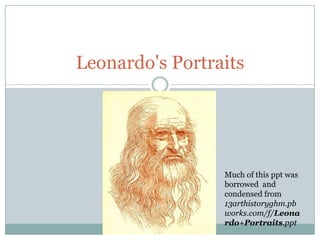LeonardoŌĆÖs portraits blog
- 1. Leonardo's Portraits Much of this ppt was borrowed and condensed from 13arthistoryghm.pb works.com/f/Leona rdo+Portraits.ppt
- 2. Leonardo's Key Innovations ŌĆó No more profileŌĆō ┬Š view of face ŌĆó Inclusion of hands ŌĆó Revealed the sitterŌĆÖs personality ŌĆó Used Symbols in a more subtle, complex way than previous Renaissance portrait artist
- 3. Patronage ’éŚ Leonardo was commissioned by several wealthy people to paint their portraits. They were called his ŌĆ£PatronsŌĆØ ’éŚ Only wealthy people could afford to be painted. ’éŚ CameraŌĆÖs were not invented therefore art was the only way to record history ’éŚ Ludovico Il Moro, Duke of Milan commissioned Leonardo to paint 2 portraits for him: one for his wife and one for his girlfriend!!!
- 4. Which one was the DukeŌĆÖs wife? Which one was the DukeŌĆÖs mistress? La Belle Ferroniere (left) The Lady with the Ermine (right)
- 5. La Belle Ferroniere 1490-96 The WIFE! Who was correct? Why did you guess that? Her pose and face tell us she is dignified. Notice her decorative dress? She was considered a fashionista of her era
- 6. Leonardo used ŌĆ£photoshopŌĆØ Portrait by another artist Although there were NO computers in the Renaissance , Leonardo IDEALISED portraits. This means he made people more beautiful in there paintings than they were in real life. She made her head more oval and used golden proportions in her face
- 7. The Lady with the Ermine ŌĆó 1. Conveys a sense of mystery and the uniqueness of the human personality. A gentle smile plays on the corners of her mouth, sparkle in her eyes. (Like the Mona Lisa!) ŌĆó 2. Pose is innovative [again!]. ŌĆó 3. Use of Sfumato ŌĆō veils of soft glazes, gradual blending of tones that create a ŌĆ£smokyŌĆØ effect
- 8. Who was she? ŌĆó Member of the noble Gallerani family. ŌĆó Became the Mistress of Duke of Milan at age 15. ŌĆó About 16-17 at time portrait painted ŌĆó Duke then married Beatrice Este, but kept visiting Cecilia. He kept her in a castle, She kept this portrait. ŌĆó She later married in 1491.
- 9. What do her physical characteristics suggest about her? ŌĆó Her figure is slender,ŌĆō the action of turning suggest her agility and physical energy ŌĆó fingers long and delicate ŌĆō gracefulness ŌĆó The light in her eyes ŌĆō an active and alert mind ŌĆó Glow in her cheeks ŌĆō warmth, beauty of spirit ŌĆó Her neatly groomed hairstyle ŌĆō fashionable, yet simple. Modest.
- 10. The meaning of the Ermine . She is the mistress of Il Moro - the ermine was his symbol, featured on his Coat of Arms. 2. As his mistress, she is like his pet. 3. In Greek, ermine is ŌĆ£galenŌĆØ ŌĆō a pun on her surname Gallerani 1. The ermine symbolises her virtue. In Medieval bestiaries the animal was described as the ŌĆśessence of purity and moderationŌĆÖ. ŌĆ£it would rather die than soil itself and is so moderate it only eats once a dayŌĆØ. These qualities are attached to Cecilia. 1. The ermine is her mirror. It moves lithely and has bright eyes, alert neck - echoed in CeciliaŌĆÖs movement and alert glance. 6. The ermine was a talisman for childbirth. Some say she may have been in the early stages of pregnancy while this was painted







![The Lady with the Ermine
ŌĆó 1. Conveys a sense of mystery
and the uniqueness of the
human personality. A gentle
smile plays on the corners of
her mouth, sparkle in her eyes.
(Like the Mona Lisa!)
ŌĆó 2. Pose is innovative [again!].
ŌĆó 3. Use of Sfumato ŌĆō veils of
soft glazes, gradual blending of
tones that create a ŌĆ£smokyŌĆØ
effect](https://image.slidesharecdn.com/leonardosportraitsblog-121010111342-phpapp01/85/Leonardo-s-portraits-blog-7-320.jpg)



